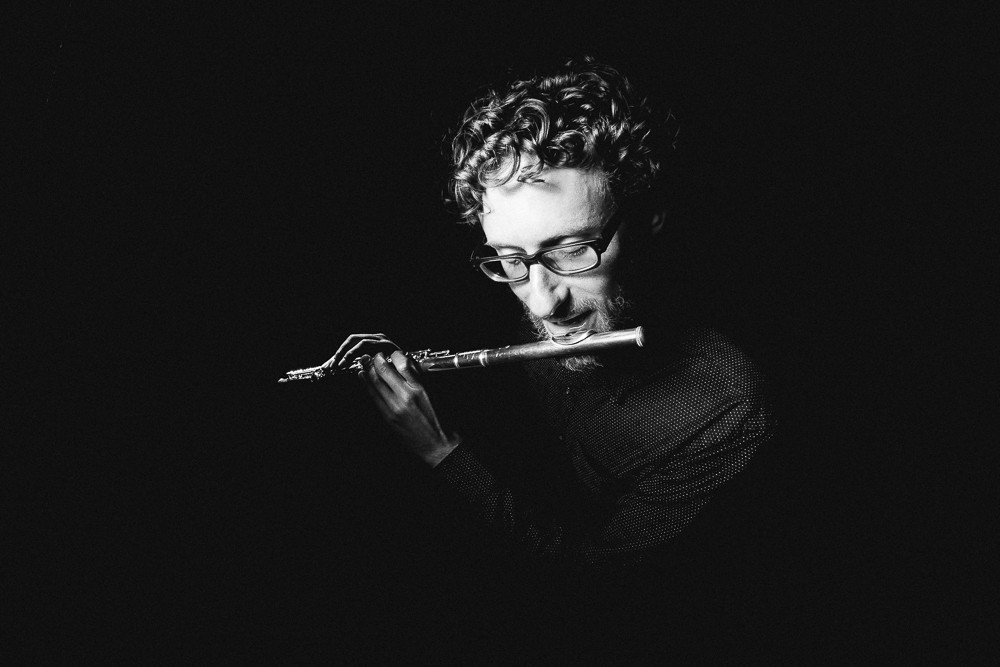★★★½☆ Tim Munro takes us on a nocturnal journey between sleeping and waking.
Miller Theatre, Columbia University, New York
November 10, 2016
Brisbane-born, three-time Grammy award winning flautist Tim Munro made his New York debut at Columbia University’s Miller Theatre with a daring programme of contemporary works, including two world premieres. Munro’s playing is quite unique, showcasing the theatrical and performative aspects of the instrument. No part of the flute is left unharnessed, and no sound is beyond his scope. He moves easily from flute to piccolo, and even infuses singing and acting in a holistic presentation. The thread that runs through this program is the idea of consciousness, of the transition between sleep and waking, and of psychological journeys. While the stage is sparse, the lighting designer Mary Ellen Stebbins created a dreamy and hypnotic ambience.
 Australian flautist Tim Munro
Australian flautist Tim Munro
Written in the programme note were these lines: “But even more than any overarching theme, the programme is imbued with Munro’s sense of whimsical adventure and radiant beauty – a contemporary slant, perhaps, on the Romantic yearning for the sublime.” I couldn’t help but think of Keats’ poem Ode to a Nightingale, particularly fitting here given the birdlike nature of the flute’s sound and the sonic evocation of wandering throughout. Much of the music performed felt like the last two lines from that nineteenth century poem: “Was it a vision, or a waking dream? / Fled is that music: – Do I wake or sleep?”
The first item on the programme was the Swedish composer Malin Bång’s Alpha Waves (2008), a piece that conjures the thought patterns of the sleeping brain. To do this, Munro becomes a one-man orchestra through his flute, inhaling and exhaling, whispering, creating percussive sounds on the keys, and interspersing these techniques with quite virtuosic passages of classical flute playing.
For the second item Munro laid down his flute to join four members of Face the Music, “the only living orchestra in the US dedicated to the creation and performance of music by living composers”. They performed American composer Tom Johnson’s 1982 work Counting Duets. It is a fun, light-hearted composition in which Munro exchanges counting numbers with each member of the group as a duet. There is randomness in each engagement, but there is also an inherent logic to the counting. It was entertaining, with Munro proving to be quite the actor, able to be both candid and sardonic.
Johnson was followed by another unique piece by David Reminick, Seven Somniloquies (2016) The composer explains in the programme note that his partner is a prolific sleeptalker, and he tries to capture – through flute and singing – the coherence, repetition and randomness of her nocturnal soliloquies. Described by Munro as the hardest work he has performed, this singing flautist put on quite a Herculean effort, transitioning from singing to playing, evocatively conveying those surreal moments between sleep and consciousness.
Soprano Kate Soper performed in her own composition alongside Munro, Only the Words Themselves Mean What They Say (2010-11). Constructed in three movements, the piece is a dialogue between Munro on the flute, representing a recalcitrant boyfriend, and Soper, the exasperated girlfriend trying to navigate the demands of a relationship. The work was highly demanding technically on both performers, but it was well choreographed and orchestrated, and highly amusing to boot.
The final two works ran into one another to round out the concert. First, Munro, the dedicatee, performed Brett Dean’s Notes from the Twittersphere (2015), a miniature that evokes the avian sounds that Dean heard in the courtyard of his apartment in Berlin. The idea, said Dean, was to wrest the twittersphere back for the birds. Given the political backdrop and the omnipresence of Twitter in the election, one might say that Munro and Dean were Making Twitter Great Again.
The concert ended with Christopher Cerrone’s mammoth Liminal Highway (2016), a work for flutter-tongue piccolo and four-channel electronics, incorporating sampling to create the illusion of an entire wind orchestra. Thematically, this layered sound evokes falling asleep in transit, the premise of the Canadian indie rock musician John K. Samson’s poem of the same name. The work is supremely enchanting and hypnotic, minimalist in conception but employing stunning harmonies. Again the Romantic sonic-conjurer Munro drew me to the words of Keats: “Away! away! for I will fly to thee, / Not charioted by Bacchus and his pards, / But on the viewless wings of Poesy, / Though the dull brain perplexes and retards”.
Cerrone is obviously versed in the classical tradition, as this piece in five movements, with an arch-like form where seeds are sewn in early movements to be picked up in later movements, is a nice nod to the cyclic symphony beginning with Berlioz’s Symphonie Fantastique. No great Romantic performance is complete without a nod to the effects of alcohol; in the final movement Munro sets aside the flute for a set of mounted beer bottles to add to the sonic mix and another transformation on the acoustic highway. As Keats reminds us, “O, for a draught of vintage! that hath been / Cool’d a long age in the deep-delved earth”.











Comments
Log in to join the conversation.